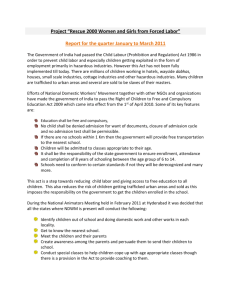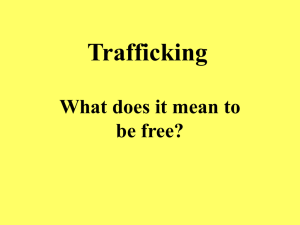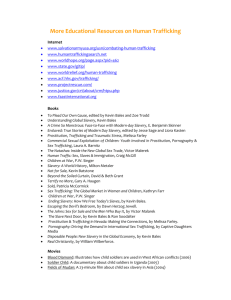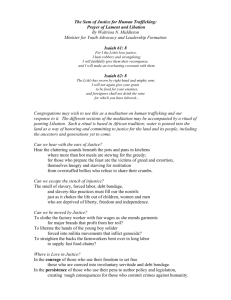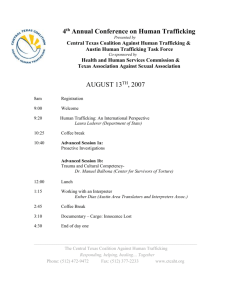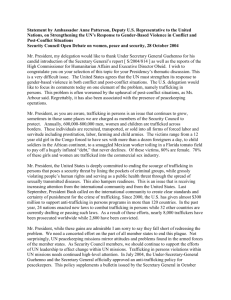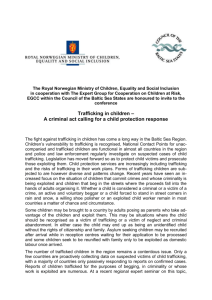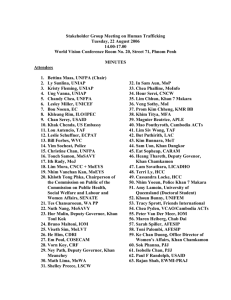Human Trafficking in Cambodia
advertisement
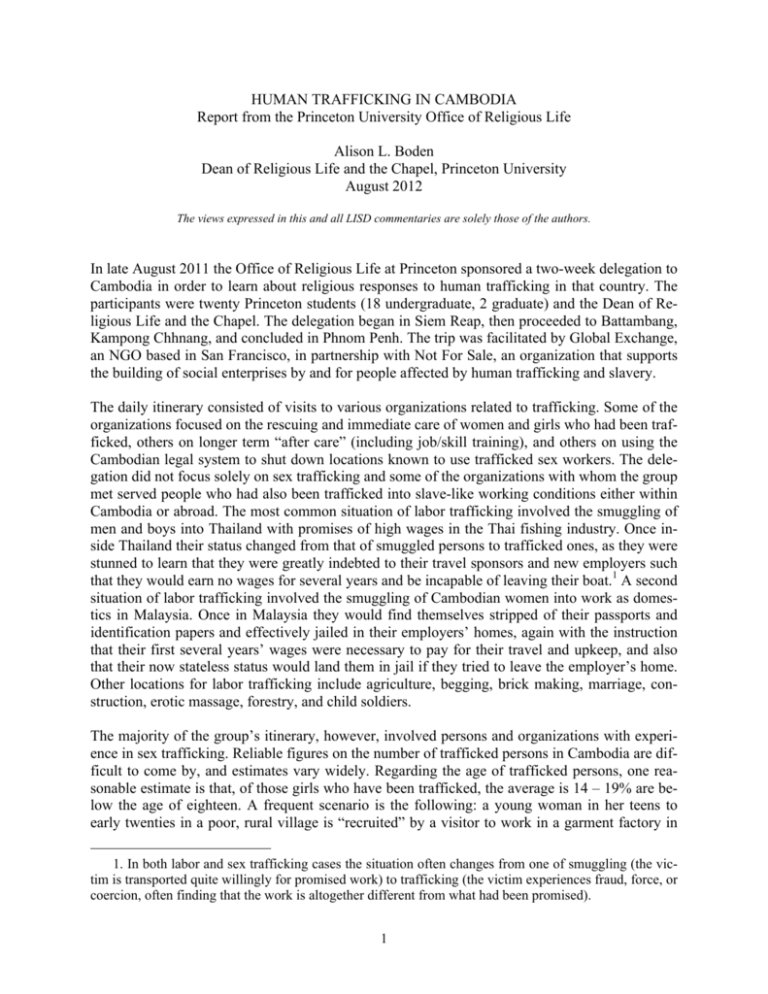
HUMAN TRAFFICKING IN CAMBODIA Report from the Princeton University Office of Religious Life Alison L. Boden Dean of Religious Life and the Chapel, Princeton University August 2012 The views expressed in this and all LISD commentaries are solely those of the authors. In late August 2011 the Office of Religious Life at Princeton sponsored a two-week delegation to Cambodia in order to learn about religious responses to human trafficking in that country. The participants were twenty Princeton students (18 undergraduate, 2 graduate) and the Dean of Religious Life and the Chapel. The delegation began in Siem Reap, then proceeded to Battambang, Kampong Chhnang, and concluded in Phnom Penh. The trip was facilitated by Global Exchange, an NGO based in San Francisco, in partnership with Not For Sale, an organization that supports the building of social enterprises by and for people affected by human trafficking and slavery. The daily itinerary consisted of visits to various organizations related to trafficking. Some of the organizations focused on the rescuing and immediate care of women and girls who had been trafficked, others on longer term “after care” (including job/skill training), and others on using the Cambodian legal system to shut down locations known to use trafficked sex workers. The delegation did not focus solely on sex trafficking and some of the organizations with whom the group met served people who had also been trafficked into slave-like working conditions either within Cambodia or abroad. The most common situation of labor trafficking involved the smuggling of men and boys into Thailand with promises of high wages in the Thai fishing industry. Once inside Thailand their status changed from that of smuggled persons to trafficked ones, as they were stunned to learn that they were greatly indebted to their travel sponsors and new employers such that they would earn no wages for several years and be incapable of leaving their boat.1 A second situation of labor trafficking involved the smuggling of Cambodian women into work as domestics in Malaysia. Once in Malaysia they would find themselves stripped of their passports and identification papers and effectively jailed in their employers’ homes, again with the instruction that their first several years’ wages were necessary to pay for their travel and upkeep, and also that their now stateless status would land them in jail if they tried to leave the employer’s home. Other locations for labor trafficking include agriculture, begging, brick making, marriage, construction, erotic massage, forestry, and child soldiers. The majority of the group’s itinerary, however, involved persons and organizations with experience in sex trafficking. Reliable figures on the number of trafficked persons in Cambodia are difficult to come by, and estimates vary widely. Regarding the age of trafficked persons, one reasonable estimate is that, of those girls who have been trafficked, the average is 14 – 19% are below the age of eighteen. A frequent scenario is the following: a young woman in her teens to early twenties in a poor, rural village is “recruited” by a visitor to work in a garment factory in 1. In both labor and sex trafficking cases the situation often changes from one of smuggling (the victim is transported quite willingly for promised work) to trafficking (the victim experiences fraud, force, or coercion, often finding that the work is altogether different from what had been promised). 1 Phnom Penh, promised wages of $60 per month, even $90 if she works overtime (the average income is approximately $30 per month, although many rural Cambodians live on less). By the time she gets to the capital she is dropped off not at a factory or apartment building but at a brothel or a hostel for enslaved sex workers. Often, a member of the young woman’s family or a neighbor has received a small amount of money for selling her to the recruiter. Alone, penniless, ashamed, and under threat of violence, she has no choice but to take “clients,” often many a day. The organizations that perform the initial rescue work often enter the brothels under the guise of health workers (no brothel owner wants their establishment to be known for spreading disease so health workers are welcome). In fact, these NGO representatives are speaking confidentially with the residents to ask if they do wish to leave the brothel, as they make arrangements for a raid in a few days’ time. It is highly important that they do get strong consent from each sex worker, as it occasionally happens that a rescued young woman will return to the brothel soon afterwards, unable to imagine a life without the stigma of having been sold for sex work. The number of women rescued versus the number who would like to be is miniscule, therefore valuable resources need to be given to the women who will actually be able to transition to a new life. The Princeton delegation members learned much about the challenges of performing raids (for instance, police collusion with brothel owners), of helping women to a self-affirming identity, and of imagining a new life (having been sold by a family member many young women struggle particularly for self-worth). Because brothels are relatively easy to identify and to raid, the victims of sex trafficking are now being prostituted in other venues. In Cambodia, prostitution itself is not against law, but rather “third party procurement.” One can sell oneself, one can buy sex from another, but it is illegal to serve as pimp or brothel owner. Therefore, prostitution (trafficked or not) is shifting to karaoke bars and beer gardens. At these establishments, men arrive and order drinks. They then approach the owner and inform him that they wish to take one of his waitresses “on a date.” The client pays the bar owner money to compensate him for the temporary loss of his staff member during her shift. Those who prosecute and attempt to shut down sex trafficking establishments are indeed finding it significantly more difficult to prove that third party procurement (let alone trafficking) has happened. Also, NGOs are finding that the women are in significantly greater danger when the sex happens off-site; a brothel manager is not present to keep a distant eye/ear on his or her “property.” Those young women who are successfully rescued often spend months in after-care. Their time is spent learning a marketable skill and, in many cases, acquiring self-esteem. Because their education level is very low the training they receive is for work that requires minimal literacy. Popular professions include hair styling, making traditional handicrafts, waitressing, and serving as a hotel maid. The last three of these make excellent use of Cambodia’s fast-growing tourist industry. Often, women are also helped into these professions in a different geographical location than the one where they grew up and were sold, since the NGOs have repeated experience of rescued women being resold by the family member or neighbor who did it to them in the first place. Those NGOs whose work is to use the legal system to shut down sex establishments have a number of challenges of their own. The police and the legal system suffer significant corruption. Many of the brothels and bars where trafficked sex work happens are owned by people with rela- 2 tives in high government positions, giving them relative immunity from the law. Also, 50% of the judges in Cambodia have no legal training; they purchased their position. Thse men interpret the law erratically, to say the least. Additionally, the age of consent in Cambodia is 15, a fact that is often used in the defense of individual men found to have sex, in any context, with teenagers. The Princeton delegation had a special interest in the work of religious groups in combating trafficking, which had the unintended consequence of making many of the NGO meetings with western evangelical Christians. Human trafficking, particularly trafficking in children, is a topic of tremendous moral concern among evangelicals. In general, the Princeton group found the work that foreign Christians are doing in Cambodia to be culturally sensitive, genuinely welcomed and respected, absent of religious bias towards the women served, and absent of intent to convert. The real “location” of the westerners’ faith was in their depth of concern about the issue and their commitment to do grass-roots work to stop it. When Cambodians (who are overwhelmingly Buddhist) were asked if fellow Cambodians are doing anti-trafficking work the consistent response was, “Of course, we just don’t call it religious work. It’s simply a part of who we are.” This response is genuine of course, but also may have a lot to do with the destruction of the Sangha, the community of monks and of Buddhist infrastructure, in Cambodia during the auto-genocide of the Khmer Rouge. In fact, almost every monk in the country was killed. The Sangha has had to reconstruct itself literally from ashes. The group was struck at how strongly the Sangha has recovered in a brief amount of time, building pagodas, universities, hospitals, etc. The Princeton group’s appreciation grew each day of the indescribable distance that Cambodia has come since that recent genocide, in which perhaps a quarter of the population was killed. Infrastructure of every kind has had to be rebuilt, including the entirety of the nation’s economy. The country, it was learned, has a few dozen psychologists at present, a daunting thought given the level of trauma experienced by all who are old enough to have lived through it. The group eventually came to the understanding (perhaps not shared universally) that the profound poverty of Cambodia is the real source of human trafficking there. The depth of poverty and the absence of jobs with secure and sufficient incomes mean that people will continue to sell members of their families into sex work. Other Cambodians will be able to be duped into slavery on fishing boats and elsewhere. Some Cambodian women will continue to choose between all that is available to them – begging, prostitution, or starvation. While anti-trafficking work absolutely must continue, this work obviously needs to be paired with the building of an economy that can provide living wages. Such economic development will take time. Additionally, the group concluded that the culture of Cambodia regarding prostitution is a second contributor to the practice of sex trafficking. At a meeting with the International Justice Mission in Phnom Penh it was learned that 70% of Cambodian men and boys have their first sexual experience with a prostitute. The group was surprised throughout the trip to learn that the market for prostitution is overwhelmingly domestic. There are certainly some international sex tourists, but by and large the Cambodian women who are being trafficked are ending up in establishments with thoroughly local clients. Prostitution (and, essentially, trafficking) are unquestioned practices and a cultural norm. 3 The most recent Trafficking in Persons (TIP) report rates Cambodia a relatively respectable “2” on its 1 – 3 scale of countries’ efforts to combat trafficking (1 is the highest). The Princeton group was interested to hear from foreign service staff at the US Embassy in Phnom Penh that this higher rating (rather than a 3 or a 2.5) was meant as a “carrot” to encourage the Cambodian government to do even more. It was the impression of the embassy staff that the Cambodian government was baffled at the international concern raised by sex trafficking – with so many other pressing problems, why are people worried about some girls who end up as prostitutes? The Cambodian government would greatly prefer all international interest to be focused on expanding their economy. But growing numbers of people continue to be extremely concerned about sex trafficking, so much so that they are becoming involved somehow in the issue, even moving to Cambodia for years of their lives to work one-on-one with trafficked women and girls. When asked after the delegation if the experience in Cambodia had been discouraging or depressing, the Princeton students strongly said no. The depth of determination, of caring, and of faith in the NGO staffs and in the trafficked women themselves was a source of inspiration and of hope. 4
